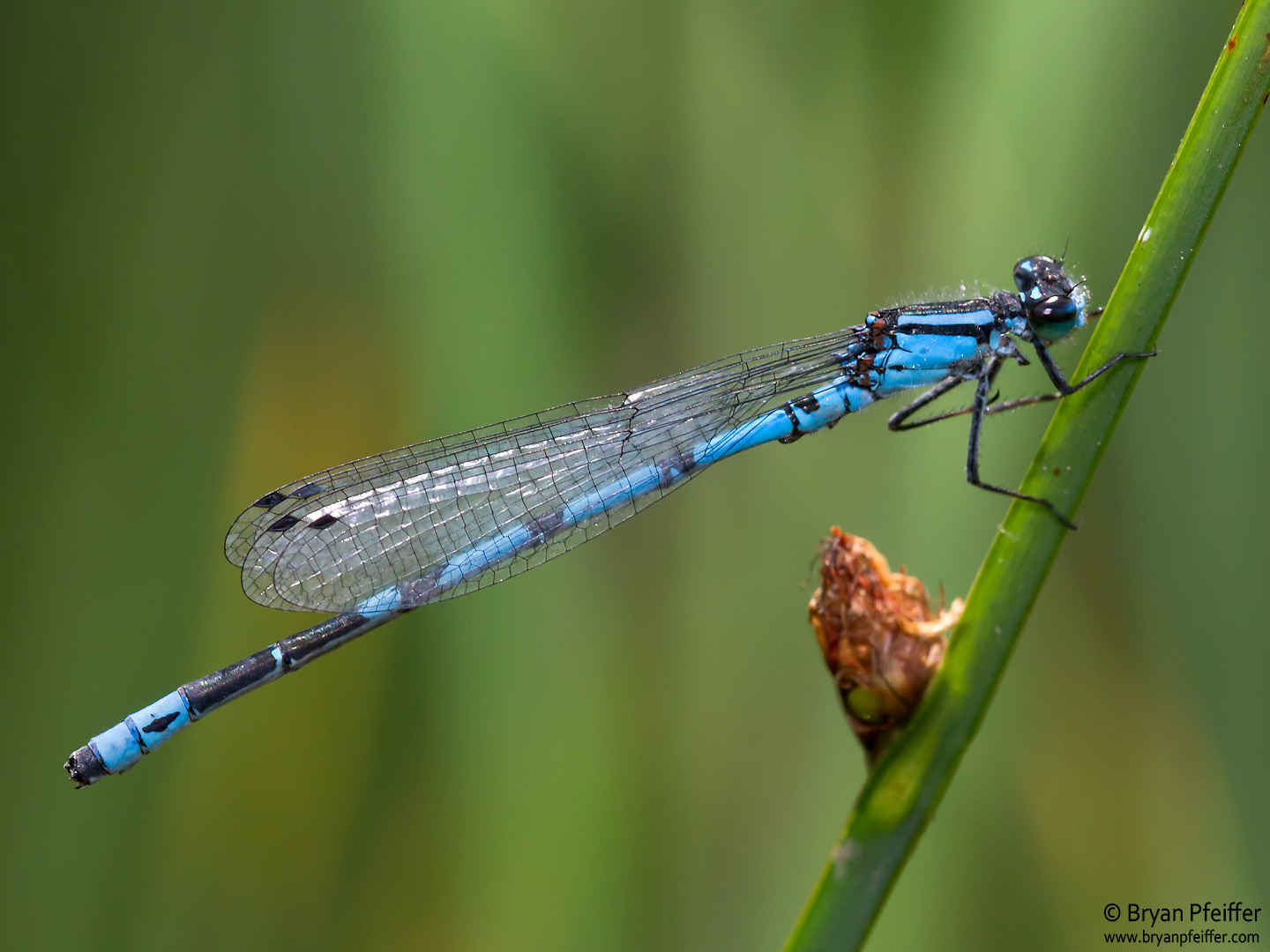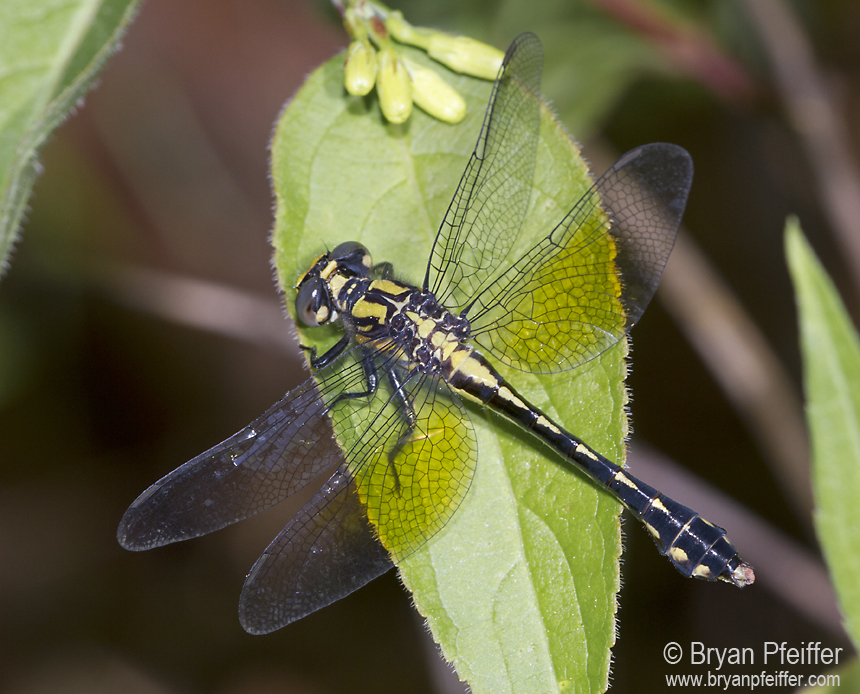
New England Bluet (Enallagma laterale) / © Bryan Pfeiffer
The Vermont Center for Ecostudies and its partners are recruiting volunteers to search the state for rare and undiscovered dragonflies and damselflies, which could be flying at your nearest river, wetland or backyard pond. We’ll even train people who want to join in the pursuit of these charismatic insects.
VCE has just published the “Distinguished Dozen” — conservation worthy species that include some of the most prized dragonflies on the continent and a few believed to breed in Vermont but have yet to be discovered.
“Dragonflies are some of the most ancient and audacious animals on earth,” said Bryan Pfeiffer, co-coordinator of the Vermont Dragonfly and Damselfly Atlas (VDDS), “and anyone who watches them go about their business, which is basically killing other insects and mating, may end up rethinking the tranquility at the local pond or favorite fishing spot.”
Included among the Distinguished Dozen are:
- Tiger Spiketail (Cordulegaster erronea), the only known sighting of which in Vermont came last summer when a fisherman snapped a photo of a mystery dragonfly along the Black River in Springfield; his find shocked project biologists.
- New England Bluet (Enallagma laterale), a tiny blue damselfly whose entire world distribution ranges from Pennsylvania to Maine, with only a single known Vermont site in Windham County.
- Incurvate Emerald (Somatochlora incurvata), showing glowing green eyes, discovered in Vermont last summer, and critically imperiled across much of its range.
- Pygmy Snaketail (Ophiogomphus howei), marked sharply in green, black and yellow, which flies only on rivers, and has never been found in Vermont despite high expectations that it lives in the state, perhaps on the White River.

Pygmy Snaketail (Ophiogomphus howei) / © Bryan Pfeiffer
The Distinguished Dozen includes species for which Vermont and the Northeast represent a significant portion of their range — and therefore could figure in the insects’ long-term fate. Find the complete list, along with a pocket-sized checklist of the state’s 145 dragonfly and damselfly species, at VDDS’s Most Wanted page.
Most anyone who visits water in summer has noticed dragonflies and damselflies, many of which can be identified from a photograph. VDDS encourages Vermonters out birdwatching, walking the dog, fishing, swimming or otherwise recreating to photograph dragonflies and damselflies and submit their images to the Vermont Atlas of Life’s iNaturalist portal. VDDA biologists will then identify the insects and add them to the project’s more than 10,000 sightings.
“Some of the rarest dragonflies in the state have been discovered by people who have no clue what they’re seeing, but simply snapped a decent photo for us,” said Kent McFarland, senior conservation biologist at VCE, which oversees the atlas.
Dragonfly project biologists will be offering a free training and field trip in June near Montpelier, limited to 10 people who agree to photograph at least two dozen dragonflies or damselflies this summer, including at areas where some of the Distinguished Dozen might reside.
“More than anything,” said Pfeiffer, “we’re trying to train a new generation of naturalists to pursue and enjoy these insects — and to carry the project forward.”
For more details visit the VDDS on VCE’s Vermont Atlas of Life site.
Vermont’s Distinguished Dozen Dragonflies and Damselflies (in approximate order of conservation importance)
- Tiger Spiketail (Cordulegaster erronea), the only known sighting of which in Vermont came when a fisherman snapped a photo along the Black River in Springfield, prefers woodland seeps and streams. We’re mounting an “expedition” to the Black River this year.
- New England Bluet (Enallagma laterale) is a tiny blue damselfly whose entire world distribution ranges from Pennsylvania to Maine, with only a single known Vermont site in Windham County. Sandy ponds in southeastern Vermont are your best bet.
- Incurvate Emerald (Somatochlora incurvata), showing glowing green eyes, was discovered in Vermont last summer, and critically imperiled across much of its range. Bogs in the Northeast Kingdom, and perhaps elsewhere across Vermont, are likely breeding locations.
- Pygmy Snaketail (Ophiogomphus howei), marked sharply in green, black and yellow, which flies only on rivers, has never been found in Vermont despite high expectations that it lives in the state. Look for it zipping low over the surface of moderate-sized, rocky rivers with shallow riffles and muddy spots. Locations on the White River come to mind.
- White Corporal (Ladona exusta), resembling its common and abundant congener Chalk-fronted Corporal (L. julia), is perhaps being overlooked, with its most likely location to be ponds in southeastern Vermont. Watch for it landing on pale surfaces, like old fallen trees.
- River Bluet (Enallagma anna) was discovered on 10 August 2014 along the Ompompanoosuc River in Thetford, which warrant more investigation for this species. It is not yet known whether this was a lone individual or part of an established population.
- Black Meadowhawk (Sympetrum danae), known from very few locations in Vermont, might turn up along shallow acidic lakes and marshes. Fairly well established across its wide range, it is simply a mystery in Vermont.
- Petite Emerald (Dorocordulia lepida) is scarce across its range from the Canadian Maritimes to West Virginia. Find it at bogs and acidic marshes and fens, perhaps streams. Although it’s been located reliably in southern Vermont, the Northeast Kingdom is probably your best bet.
- Subarctic Bluet (Coenagrion interrogatum), a boreal species, may be extirpated in Vermont. It hasn’t been found at its two known locations in years. Bogs and acidic ponds in the Northeast Kingdom is a likely holdout.
- Cyrano Darner (Nasiaeschna pentacantha), large and charismatic, known for its bulging frons (“nose”), is known from only one site in Windham County. With a wide range across the eastern U.S., this darner might turn up at any wetland, pond or slow-moving stream in Vermont.
- Common Sanddragon (Progomphus obscurus) reaches the northern portion of its range in Vermont, but has been located in New Hampshire and upstate New York. Sandy rivers are best.
- Ruby Meadowhawk (Sympetrum rubicundulum) is fake news across its mysterious range, having been misidentified for decades. We have no reliable records of this dragonfly in Vermont. Your ability to find it requires capture and close examination with a hand lens — photos won’t be good enough. Contact Dr. Michael Blust for details ().

I have an image of a exotic looking dragonfly I would like to know the species. I find them from time to time at my place of work. Who can I contact to send this image to. Im sure not many people have seen this dragonfly before.
Thanks for contacting us about your interesting dragonfly image. We suggest the best (and fastest) way to get help with insect IDs is to create an account at iNaturalist.org (https://www.inaturalist.org/), and then upload your photos of the insect. You can also download the iNaturalist app for your smartphone instead of using the web interface. If the photo was taken in Vermont (and you enter the location), it will be added to the iNaturalist project Vermont Atlas of Life, which VCE manages. The iNaturalist software will provide a list of species that it thinks are a good match (and amazingly accurately). You choose what you think it is, and then biologists here at VCE and fellow naturalists will confirm or offer up alternative identifications for your observations. It’s really fun and educational. Don’t forget to join the iNaturalist Vermont group once you are up and running! https://www.inaturalist.org/projects/vermont-atlas-of-life
Spotted what I believe is a New England bluet a couple of times recently in my back yard in Shelburne. Curious as to what I saw I Googled and came immediately upon your site. Thanks for the help in identifying the little cutie.